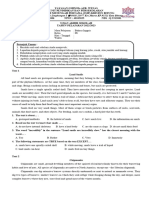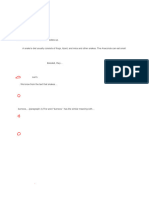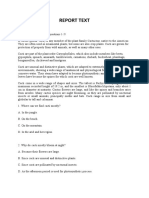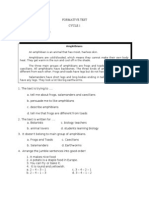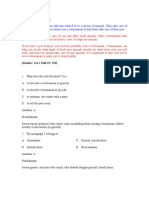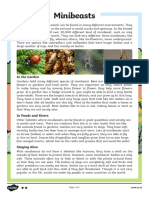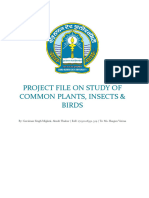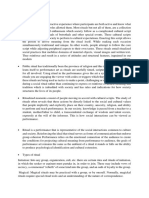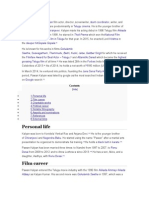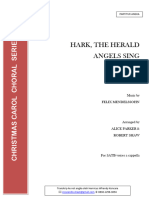PTS B Ing KL 9
PTS B Ing KL 9
Uploaded by
hevy yayangCopyright:
Available Formats
PTS B Ing KL 9
PTS B Ing KL 9
Uploaded by
hevy yayangOriginal Title
Copyright
Available Formats
Share this document
Did you find this document useful?
Is this content inappropriate?
Copyright:
Available Formats
PTS B Ing KL 9
PTS B Ing KL 9
Uploaded by
hevy yayangCopyright:
Available Formats
DINAS PENDIDIKAN DAN KEBUDAYAAN KABUPATEN
UPTD SEKOLAH MENENGAH PERTAMA
PENILAIAN TENGAH SEMESTER
TAHUN PELAJARAN 2023/2024
LEMBAR SOAL
Mata Pelajaran : Bahasa Inggris
Kelas/Semester : IX/Genap
I. Pilihlah jawaban yang paling tepat.
Text 1
Land Snails
All land snails are gastropod mollusks, meaning that they belong to the same group of octopuses, whi
ch are part of the phylum Mollusca. At the same time, they are members of the class Gastropoda, whic
h includes all snails and slugs. Being a mollusk means lacking an internal skeleton and bones, but snai
ls are protected.
Snails have a single spirally coiled shell. They have muscular foot used for creeping in most species.
Land snails are incredibly slow. Their forward speed depends on the species, but usually, it is between
0.5 and 0.7 inches per second. While moving, snails leave behind a trail of slime, a lubricant they prod
uce to allow them to go on any terrain without injuring its body. Land snails aren’t able to hear at all,
but they have eyes and olfactory organs. They use their sense of smell to help them find food being th
eir most important sensory organ.
Snails feed on very small things. Most of them scrape or brush particles from surfaces of rocks, seawe
eds, animals that don't move, and other objects. For feeding, snails use a radula, a hard plate that has t
eeth.
(Adapted from http://www.biokids.umich.edu/critters/Gastropoda/ and
https://www.snail-world.com/)
1. The text is about… .
A. gastropod mollusks
B. the habitat of snails
C. how snails live
D. the information on snails
2. Based on the text we know that snails … .
A. do not have internal skeletons
B. have a hard body
C. are the same as slugs
D. do not smell their food
3. The word “incredibly” in the sentence “Land snails are incredibly slow.” has the closest meaning
with the word… .
A. Too
B. Rather
C. Very
D. Immensly
4. The following statements are TRUE based on the text EXCEPT… .
A. snails have one spirally coiled shell
B. while moving, snails leave a trail of liquid
C. land snails can hear
D. snails feed on tiny things
Text 2
Chipmunks
Chipmunks are small, ground-dwelling members of the squirrel (Sciurida
e) family known for their burrowing habits and love of nuts. All species o
f chipmunks are native to North America, except one - the Siberian chip
munk.
Chipmunks can dig extensive burrow systems directly underneath or next
to natural or manmade cover. They dig two types of burrows: shallow bur
rows in which they seek refuge while foraging during the day, and deeper, more complex burrows wh
ere they nest, store food and spend most of the winter months.
Their average size is 5.08 until 15.24 centimeters in length. Their tail is around 7.62 centimeters long.
Their body have shades of brown/yellow/grey fur with white and black stripes down the back.
Chipmunks are omnivores, dining on various types of foods that are found mostly on the ground. Thei
r diets are more diverse during the warmer months, during which time they hoard nuts and seeds in th
eir burrows to eat in the winter.
(Adapted from https://www.havahart.com/chipmunk-facts)
5. The purpose of the writer in writing the text is to inform the readers about … .
A. the habitat of chipmunks
B. the characteristics of chipmunks
C. the body appereance of chipmunks
D. what chipmunks eat
6. Based on the text, we know that chipmunks… .
A. store food for winter
B. are the same as squirells
C. live above the ground
D. have short tail
7. The word “underneath” in the sentence “Chipmunks can dig extensive burrow systems directly
underneath ...” has the similar meaning as the word… .
A. On
B. In
C. Of
D. Below
8. The following statements are TRUE based on the text about chipmunks EXCEPT…
A. the complex burrows where they sleep
B. they only dig shallow burrows
C. they can be 5.08 until 15.24 centimeters in length
D. their diets are more diverse during the warmer months
Text 3
Groundhogs
Groundhogs, (Marmota monax), also called woodchucks, one of 14 spec
ies of marmots (Marmota). Classified as a marmot, the groundhog is a m
ember of the squirrel family, Sciuridae.
This stout-bodied rodent weighs up to 6 kg (13 pounds) and has a body length of up to 50 cm (about 2
0 inches) and a short, bushy tail up to 18 cm (7 inches) long. They have thick fur on the upper parts. T
he fur ranges in colour through various shades of brown. The fur in the feet are darker, and the underp
arts are buff.
Although groundhogs dig deep and extensive burrow systems, they are also good swimmers and can c
limb tall shrubs and sizable trees. They are most active in the morning and evening, eating grasses and
other green plants, as well as some fruit and the bark and buds of trees. They feed heavily in summer
and early fall, accumulating huge fat reserves for the winter. The animal is a true hibernator.
(Adapted from https://www.britannica.com/animal/groundhog)
9. The text is about… .
A. the classification of groundhogs
B. the information habitat and food of groundhogs
C. the information of groundhogs’ body parts
D. the information of groundhogs in general
10. Based on the text, it can be infered that….
A. groundhogs are scary animals
B. groundhogs have bushy tail
C. groundhogs cannot swim
D. groudhogs are usually not brown
11. The word “thick” in the sentence “They have thick fur on the upper parts.” has the opposite
meaning with the word… .
A. Thin
B. Small
C. Soft
D. Rare
12. Which statement is FALSE based on the text?
A. The fur of groudhogs ranges in colour through various shades of brown.
B. Groudhogs very active in the afternoon.
C. Groudhogs always have light fur.
D. Groudhogs hibernates.
Question 13 to 16
Crickets
Well, crickets live in almost every environment. They are found i
n fields and meadows, forests and grasslands, marshes and swam
ps, trees and bushes, and even caves, beaches, in anthills and und
erground.
Crickets use their long antennae to sense things around them, but
also to detect smells. Crickets use their simple eyes to detect light and shadow. They have complex ey
es which are made up of many hexagonal lenses. They can see in every direction. They eat decaying p
lant matter and seedlings.
Did you know that crickets are usually black or brown? The average cricket is about 2.54 cm long. Cri
ckets can jump 20 to 30 times their height. Crickets use jumping with their legs as their main mode of
transportation even though they have wings.
I hope the information is useful for you.
(Adapted from https://sciencing.com/cricket-habitat-5439194.html)
13. The aim of the speaker in monolog is to… .
A. tell the readers the environment of crikets
B. ensure the readers that crickets live underground too
C. inform the reade general information and facts about crickets
D. entertain the readers about crickets
14. From the monolog, we know that crickets… .
A. can swim
B. have one antennae
C. detect light using their antennae
D. have good eyesight
15. The word “every” in the sentence “They can see in every direction.” can be best replaced by the
word….
A. Multiple
B. Some
C. All
D. One
16. The following statements are TRUE based on the monolog EXCEPT….
A. crickets use their long antennae to detect smells
B. crickets eat seedlings
C. crickets are can be black
D. crickets only use wings to move their body
Questions 17 to 20.
Grasshoppers
Grasshopper, any of a group of jumping insects (suborder Caelife
ra) that are found in a variety of habitats. There are around 11,000
known species of grasshoppers in the Caelifera suborder.
Okay, let me continue. Grasshoppers are ground-dwelling insects
with the ability to jump long distances to evade threats. Grasshop
pers occur in greatest numbers in lowland tropical forests, semiari
d regions, and grasslands. Grasshoppers are herbivorous. They eat
plants and other types of vegetation.
Well, grasshoppers can be identified by their two antennas, four small legs, two enlarged legs and elo
ngated shape. A grasshopper’s jump, assisted with its wings, can reach a speed of up to eight miles pe
r hour. A large grasshopper can jump between 10 and 20 times its body length without the aid of its w
ings. Grasshoppers are commonly brown and green or a mixture of the two. However, there are some
species of grasshoppers that have a wide range of vivid colors, like the rainbow
grasshopper.
I hope the information is useful for you.
See you!
(Adapted from https://www.britannica.com/animal/grasshopper-insect and
https://www.factsjustforkids.com/insect-facts/grasshopper-facts-for-kids.html)
17. The monolog is about… .
A. where grasshoppers live
B. the ability of grasshoppers
C. the body parts of grasshoppers
D. the general characteristics of grasshoppers
18. Based on the monolog, we know that grasshoppers… .
A. can jump very fast
B. have only green color shades
C. do not live underground
D. eat other insects
19. The word “aid” in the sentence “A large grasshopper can …its body length without the aid of its
wings.” can be replaced by ….
A. Existence
B. Help
C. Role
D. Power
20. Which statement is FALSE based on the monolog?
A. A great number of grasshoppers can be found in lowland tropical forests.
B. A grasshopper’s jump can reach a speed of up to eight miles per hour.
C. Grasshoppers’ four large legs are all large and strong.
D. There are grasshoppers having rainbow-like color.
Read the following text to answer questions number 17 to 21
The Magic Box
Once upon a time, there was a poor farmer who lived with his wife. One day, he dug up his field and f
ound a big box. He took it home with him and showed it to his wife. His wife cleaned the box and kep
t it in their house.
One sunny morning his wife dropped an apple into it. Suddenly the box began fill up with apples. No
matter how many the apples were taken out, more apples took their place. So the farmer and his wife
decide to sell the apples and in short time they were able to live quite comfortably. One day, the farme
r dropped a gold coin into the box. At once, apples disappeared and the box began to fill itself with co
ins. Every day, the farmer and his wife collected hundreds of gold coins from the box. Soon they beca
me very rich.
Having heard that his son had gone rich, the farmer‟s grandfather visited the couple. He was not very
strong and he could not go out to work anymore. So the farmer asked the old man to help him take the
money out of the box. When his grandfather told his son that he was tired and wanted to have arrest, t
he farmer shouted at him,” why are you so lazy? Why can‟t you work harder?” The old man didn‟t sa
y anything, and continued to work until he fell into the box and suddenly died. At once, the money dis
appeared and the box began to fill up with dead grandfathers.
The farmer had to pull them out and bury them. To do this, he had to spend all the money he had colle
cted. When he had used up all the money, the box broke and the farmer was just as poor as he was bef
ore.
21. What is the type of the text above?
A. Recount B. Report C. Narrative D. News item
22. What is the purpose of the text?
A. to amuse the readers C. to inform about the magic box
B. to describe the magic box D. to give information about the magic box
23. Which statement is TRUE according to the story?
A.The box was full of valuable things when it found
B.The farmer had to pull out his father’s bodies and bury them
C.The poor farmer was finally killed by his father
D.The farmer’s wife was happy after the father passed away
24. What we can learn from the story?
A. Being honest is not always wise C. We must respect our parents
B. It is good to be honest in life D. Being a miser is sometimes important
25. What is the meaning of word “prosperous” in the third paragraph?
A. Rich B. Poor C. Smart D. Wise
26. George doesn’t want to clean the room. He doesn’t want to . . . .
A. ordered B. be ordered C. order D. ordering
27. Choose the correct answer to complete the conversation!
A: Why can’t I find my script files on this laptop?
B: It’s already gone because the laptop . . . . yesterday.
A. Be fixed B. Fixed C. Was fixed D. Are fixed
28. Choose the correct answer to complete the conversation!
A: Why are you so hurry?
B: I have to arrive there on time because I . . . by my fiends there.
A. Waited B. to be waited C. Am waiting D. am waited
29. Choose the correct answer to complete the conversation!
A: The room is so dark. I think the lamps is broken.
B: You are right! The lamps . . . a long time ago.
A. Repairs B. Repaired C. To be repaired D. Should have been repaired
30. Choose the correct answer to complete the conversation!
A: Why does he panic?
B: He is panic because his name . . . by the principal.
A. is called B. was called C. are called D. were called
31. The window . . . since three days ago.
A. Is cleaned B. Has not been cleaned C. Have not been cleaned D. To be cleaned
32. Do you know that the new rules about smoking . . . by government for the time being.
A. Are discussing B. Are discussed C. Is being discussed D. It is discussede
33. He is still waiting . . . for job interview.
A. to be calling B. are being called C. Called D. to be called
34. The chair is not here anymore. It must have . . .
A. been taking away C. take away
B. taken away D. been taken away
For number 31 to 40, Change the sentences into passive voice
35. I eat brown rice and green beans. The Passive form of the sentence is…
A. Brown rice and green beans is ate by me.
B. Brown rice and green beans is eaten by me.
C. Brown rice and green beans are ate by me.
D. Brown rice and green beans are eaten by me.
36. He rides a fixed-gear bike. The Passive form of the sentence is…
A. A fixed-gear bike is ridden by him.
B. A fixed-gear bike is rode by him.
C. A fixed-gear bike are ridden by him.
D. A fixed-gear bike are rode by him.
37. They access the internet. The Passive form of the sentence is…
A. The internet are access by them. C. The internet are accessed by them.
B. The internet is accessed by them. D. The internet is access by them.
38. She brings little money. The Passive form of the sentence is…
A. Little money is bring by her. C. Little money is brought by her.
B. Little money are brought by her. D. Little money are bring by her.
39. We need extra pillows. The Passive form of the sentence is…
A. Extra pillows are need by us. C. Extra pillows are needed by us.
B. Extra pillows is needed by us. D. Extra pillows is need by us
40. He plays the game. The Passive form of the sentence is…
A. The game is play by him. C. The game are play by him.
B. The game is played by him. D. The game are played by him.
41. My father reads a daily newspaper. The Passive form of the sentence is…
A. A daily newspaper is readed by my father.
B. A daily newspaper are read by my father.
C. A daily newspaper are readed by my father.
D. A daily newspaper is read by my father.
42. The customer service officers answer my questions. The Passive form of the sentence is…
A. My questions are answered by the customer service officers.
B. My questions is answered by the customer service officers.
C. My questions are answer by the customer service officers.
D. My questions is answered by the customer service officers.
43. Do the workers operate those tower cranes? The Passive form of the sentence is…
A. Is those tower cranes operated by the people?
B. Are those tower cranes operate by the people?
C. Is those tower cranes operate by the people?
D. Are those tower cranes operated by the people?
44. The tower crane operators wear a hard hat. The Passive form of the sentence is…
A. A hard hat are wore by the tower crane operators.
B. A hard hat is worn by the tower crane operators.
C. A hard hat are worn by the tower crane operators.
D. A hard hat is wore by the tower crane operators.
You might also like
- The Max StrategyDocument60 pagesThe Max Strategykfine55314057% (7)
- Digital Booklet - HumbugDocument6 pagesDigital Booklet - HumbugKatie Kasper100% (1)
- Academic Reading: Practice TestDocument7 pagesAcademic Reading: Practice TestJane Angel PersulessyNo ratings yet
- UAS Bhs Inggris Kelas IXDocument7 pagesUAS Bhs Inggris Kelas IXadam.ardhana0307No ratings yet
- Soal Latihan Bahasa Inggris Kelas 9Document3 pagesSoal Latihan Bahasa Inggris Kelas 9Rundown GirlNo ratings yet
- Soal PTS 2 B.ing Kelas 9 K13Document6 pagesSoal PTS 2 B.ing Kelas 9 K13Cantika AnjanaNo ratings yet
- Soal PTS Bahasa Inggris Kelas 9Document6 pagesSoal PTS Bahasa Inggris Kelas 9Farra Pitaloka09No ratings yet
- Soal Pts 2 B.ing Kelas 9 k13Document7 pagesSoal Pts 2 B.ing Kelas 9 k13Tindy RasmaNo ratings yet
- SOAL PTS B.ING KELAS 9 K13 - WEBSITE WWW - Kherysuryawan.idDocument7 pagesSOAL PTS B.ING KELAS 9 K13 - WEBSITE WWW - Kherysuryawan.idDarul muttaqinNo ratings yet
- Kisi-Kisi English PTSDocument7 pagesKisi-Kisi English PTSZie MaNo ratings yet
- Pas Ix Genap 2021-2022Document4 pagesPas Ix Genap 2021-2022Tindy RasmaNo ratings yet
- Soal&kunci JWBN Uas B.ing KLS 9 April 2024Document2 pagesSoal&kunci JWBN Uas B.ing KLS 9 April 2024abni.amiman0708No ratings yet
- Usmb Ing XiDocument16 pagesUsmb Ing XiReqistaAndiniNo ratings yet
- Soal Pat 2020 2021 EditDocument15 pagesSoal Pat 2020 2021 Editsabngatun samaraNo ratings yet
- Latihan Text Report AnimalDocument5 pagesLatihan Text Report AnimalRaihan UshaimNo ratings yet
- Report TextDocument8 pagesReport TextabeskyNo ratings yet
- LATIHAN SOAL REPORT TEXT 8Document4 pagesLATIHAN SOAL REPORT TEXT 8Wiwin Prihatini S.pdNo ratings yet
- Wisma Pri IIIDocument5 pagesWisma Pri IIIAndi PratamaNo ratings yet
- SOAL STS SEM 1 RemidiDocument11 pagesSOAL STS SEM 1 Remidizeeyna79No ratings yet
- Tugas Mandiri Selama US KLS X IPA-IPSDocument17 pagesTugas Mandiri Selama US KLS X IPA-IPSDzakwan DhiyaNo ratings yet
- Report Text PracticeDocument7 pagesReport Text PracticeavocadohyukNo ratings yet
- Soal Factual, Exposition and BiographyDocument45 pagesSoal Factual, Exposition and BiographyFabiolaIvonyNo ratings yet
- Choose The Best Answer by Crossing The Option ADocument5 pagesChoose The Best Answer by Crossing The Option Aannisamustikanthi30No ratings yet
- Soal2 ReportDocument9 pagesSoal2 ReportDelfianti AdekNo ratings yet
- Soal Pts Kelas 6 FixDocument11 pagesSoal Pts Kelas 6 FixLa VictorieNo ratings yet
- Text 1 For Questions 1 To 4: Drill 13Document4 pagesText 1 For Questions 1 To 4: Drill 13Rangga SaputraNo ratings yet
- Report Text SoalDocument10 pagesReport Text SoalRifqi ZakwanNo ratings yet
- Latihan Soal Bahasa Dan Sastra InggrisDocument4 pagesLatihan Soal Bahasa Dan Sastra Inggrisenglish teacherNo ratings yet
- Formative Test 1Document5 pagesFormative Test 1AyulLienna JolLieNo ratings yet
- Report TextDocument7 pagesReport TextsmpNo ratings yet
- Report Text ExamDocument7 pagesReport Text ExamGusti Ayu Cantika Cordelia CandraNo ratings yet
- Kelas Xi Semester Ganjil T.P. 2009-2010: Ulangan Semester Bersama Bahasa InggrisDocument11 pagesKelas Xi Semester Ganjil T.P. 2009-2010: Ulangan Semester Bersama Bahasa InggrisGieNo ratings yet
- Soal Ukk X RPL TSM 2023 IqbalDocument5 pagesSoal Ukk X RPL TSM 2023 IqbalcallmebalNo ratings yet
- ReportDocument52 pagesReportRiza FatimahNo ratings yet
- UH 2 MorningDocument25 pagesUH 2 MorningNur FajrinaNo ratings yet
- Soalku Asts 9Document7 pagesSoalku Asts 9SDN 1 BONOSARINo ratings yet
- Contoh Soal Report TeksDocument6 pagesContoh Soal Report Teksputri kembarNo ratings yet
- Soal B.inggris Text ReportDocument5 pagesSoal B.inggris Text Reporthervina puspita darmayantiNo ratings yet
- 9 Bahasa InggrisDocument5 pages9 Bahasa InggrisLefika NovitaNo ratings yet
- English PutriDocument3 pagesEnglish PutriRendy DunggioNo ratings yet
- ULANGAN FORMATIF 9th Grade Report TextDocument5 pagesULANGAN FORMATIF 9th Grade Report Textachmadfaishol51No ratings yet
- Anggraeni Kusuma Dewi Xii Iis Bahasa Inggris (UH 4/SOAL REPORT TEXT)Document7 pagesAnggraeni Kusuma Dewi Xii Iis Bahasa Inggris (UH 4/SOAL REPORT TEXT)prabaswara xxNo ratings yet
- Ulangan Report TextDocument9 pagesUlangan Report TextTria Oktavia100% (1)
- 9th Grade Amazon Snakes AllDocument7 pages9th Grade Amazon Snakes Allصافي الحسينNo ratings yet
- REPORTDocument8 pagesREPORTsutopoNo ratings yet
- LKPD Report TextDocument8 pagesLKPD Report Textrehanfatiha0No ratings yet
- Latihan TOEFL ReadingDocument3 pagesLatihan TOEFL ReadingsusannnnnnNo ratings yet
- Report Text Dan Soal 1Document12 pagesReport Text Dan Soal 1sabrina shifaNo ratings yet
- Report TaskDocument6 pagesReport Taskaidon siskandarNo ratings yet
- ReportDocument5 pagesReportRaden Mas Wahyu HadiningratNo ratings yet
- Soal Report Text: Nama: Indra Putra O.A Kelas: XI IPA 1Document6 pagesSoal Report Text: Nama: Indra Putra O.A Kelas: XI IPA 1aritonang88No ratings yet
- Minibeasts - MA - Kai Soon 19.2.2021Document2 pagesMinibeasts - MA - Kai Soon 19.2.2021Bob LoNo ratings yet
- Soal Report Perbandingan Report 23Document3 pagesSoal Report Perbandingan Report 23muhammad.alyfasha2No ratings yet
- Project File On Study of Common Plants, Insects & BirdsDocument27 pagesProject File On Study of Common Plants, Insects & Birds23f1002144100% (1)
- Soal Am BHS InggrisDocument17 pagesSoal Am BHS InggrisImam KurniawanNo ratings yet
- Vocabulary 200810Document2 pagesVocabulary 200810david_adie20085084No ratings yet
- Soal Report TextDocument5 pagesSoal Report TexthilmyNo ratings yet
- Exercise Bahasa InggrisDocument4 pagesExercise Bahasa Inggrisenglish teacherNo ratings yet
- Reading - MS. NganDocument2 pagesReading - MS. NganNguyễn Tài TuệNo ratings yet
- SheesDocument7 pagesSheesMuhammad MaulanaNo ratings yet
- Animal Zone 9k13Document4 pagesAnimal Zone 9k13Akhmad AlwiNo ratings yet
- Differences Between Ritual and TheaterDocument3 pagesDifferences Between Ritual and TheaterRaymond BrewerNo ratings yet
- Sonata in Am (D14) 2 Allegro by Silvius Leopold WeissDocument11 pagesSonata in Am (D14) 2 Allegro by Silvius Leopold WeissumitNo ratings yet
- Wood Elves Army BuilderDocument3 pagesWood Elves Army BuilderDan HallNo ratings yet
- English Exercises For ChildrenDocument1 pageEnglish Exercises For ChildrenBubulina100% (1)
- Drone Sprint Challenge K-Semanis 24Document7 pagesDrone Sprint Challenge K-Semanis 24FAWWAZ ÆNo ratings yet
- DIGIEVER NVR User Manual ENG PDFDocument281 pagesDIGIEVER NVR User Manual ENG PDFManolo Fernandez CarrilloNo ratings yet
- Soal Ulangan Harian 1Document2 pagesSoal Ulangan Harian 1Febri Duwi HijayantoNo ratings yet
- JT Brennan Music Biography - Google SearchDocument1 pageJT Brennan Music Biography - Google Searchjtbrennanmusic4084No ratings yet
- Alpaca YarnDocument2 pagesAlpaca YarnSantosh KumarNo ratings yet
- Test Unit 2 For 6to GradeDocument3 pagesTest Unit 2 For 6to GradeArmando González De GraciaNo ratings yet
- Great Expectations Full Book Summary SparkNotesDocument1 pageGreat Expectations Full Book Summary SparkNotesLamija FehrićNo ratings yet
- Personal Life: Akkada Ammayi Ikkada Abbayi Tholi PremaDocument3 pagesPersonal Life: Akkada Ammayi Ikkada Abbayi Tholi PremaSai KuamrNo ratings yet
- Alice Parker - Hark The Herald Angels Sing - SATBDocument5 pagesAlice Parker - Hark The Herald Angels Sing - SATBAlfirson BakarbessyNo ratings yet
- OCC Simulation ReportDocument8 pagesOCC Simulation ReportshobitNo ratings yet
- ACC120 Lab 8Document4 pagesACC120 Lab 8Shanti KusumaningrumNo ratings yet
- RMC Chennai - Scientists STD Code 044: Venky - Chandu@yahoo - Co.inDocument1 pageRMC Chennai - Scientists STD Code 044: Venky - Chandu@yahoo - Co.inchinna rajaNo ratings yet
- Oakwood Grange Lane, Oakwood, Ls8 2Pf: En-Suite BathroomDocument2 pagesOakwood Grange Lane, Oakwood, Ls8 2Pf: En-Suite BathroomHappy AdelaNo ratings yet
- Plant KingdomDocument11 pagesPlant Kingdomkumardheeraj93570No ratings yet
- MoussakaDocument2 pagesMoussakaDewayne AginNo ratings yet
- 2º+ESO ExersisesDocument41 pages2º+ESO ExersisesTeresa Gutierrez FernandezNo ratings yet
- Siemens S7-300 - 400 CP-343-1 Ethernet Connection GuideDocument5 pagesSiemens S7-300 - 400 CP-343-1 Ethernet Connection GuideSandeep YadavNo ratings yet
- Type of Natural Vegetation-GeographyDocument2 pagesType of Natural Vegetation-GeographyEunice Chan0% (1)
- Mind Your GrammarDocument1 pageMind Your GrammarLizZelencichNo ratings yet
- Principal-Timpani Audition 2023Document20 pagesPrincipal-Timpani Audition 2023DonaldNo ratings yet
- Discovery CityDocument10 pagesDiscovery Cityakshay lingaNo ratings yet
- Survey QuestionnaireDocument4 pagesSurvey QuestionnaireMichaela De GuzmanNo ratings yet
- Tiny Coffee CupDocument5 pagesTiny Coffee Cupimkailee123No ratings yet
- Athens in 4 Days Packed ItineraryDocument29 pagesAthens in 4 Days Packed ItineraryMarky GabrielaNo ratings yet











